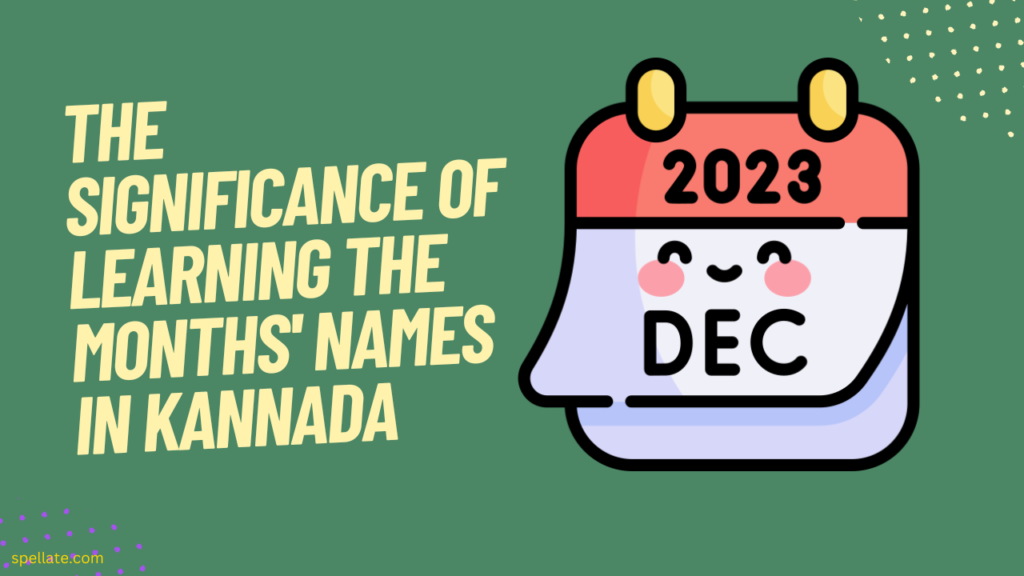Kannada, the official language of the southern Indian state of Karnataka, is rich in culture and heritage. One of the fascinating aspects of the Kannada language is its unique system of naming the months. The Kannada calendar follows a lunar-based system and consists of 12 months, each with its own distinct name and significance. These month names hold deep historical and cultural significance, reflecting the diverse traditions and beliefs of the people who speak this beautiful language.
In this article, we will explore the months name in Kannada, providing insight into the cultural tapestry of Karnataka and the significance of each month’s name in the Kannada calendar. Join us on this journey as we delve into the enchanting world of the months name in Kannada and discover the stories behind their names.
List And Meaning Of All 12 Months Name In Kannada

Kannada is one of the oldest languages in India, and it’s known for its rich cultural heritage. It’s spoken by around 50 million people worldwide, making it one of the most widely spoken Dravidian languages. Kannada has a unique tradition of naming months based on traditional beliefs and practices. In Kannada, there are twelve months in a year that are named after various astronomical events or seasons.
1. Chaitra (ಚೈತ್ರ):
Chaitra is the first month of the Kannada calendar, falling in March-April. The name Chaitra is derived from the Sanskrit word “Chaitra,” which means “bright” or “clear.” It signifies the beginning of the spring season and is considered auspicious for new beginnings, marriages, and agricultural activities. The month of Chaitra is associated with the festival of Ugadi, which marks the New Year in Karnataka.
2. Vaishakha (ವೈಶಾಖ):
Vaishakha corresponds to April-May and is named after the star “Vishakha” in the zodiac system. It is a significant month for both agricultural and religious activities. Farmers celebrate the harvest of the Rabi crops during this time. Additionally, Vaishakha is associated with the birth anniversary of Lord Parashurama, the sixth incarnation of Lord Vishnu. Devotees perform special rituals and prayers to seek blessings and good fortune.
3. Jyeshta (ಜ್ಯೇಷ್ಠ):
Jyeshta falls in May-June and gets its name from the star “Jyeshta” in the constellation system. The name Jyeshta means “the eldest” or “supreme.” It is a month associated with growth and prosperity. Farmers prepare for the upcoming monsoon season and start sowing seeds for the Kharif crops. Jyeshta is also considered an auspicious month for performing spiritual practices and seeking blessings for overall well-being and success.
4. Ashada (ಆಷಾಢ):
Ashada corresponds to June-July and is named after the star “Ashada” in the zodiac system. It is a month of the monsoon season and holds great significance for farmers. Ashada is a time of preparation for the upcoming planting season, as farmers plow their fields and make necessary arrangements. It is also considered an auspicious month for devotees of Lord Shiva, who observe fasts and offer prayers to seek his blessings.
5. Shravana (ಶ್ರಾವಣ):
Shravana falls in July-August and is named after the star “Shravana” in the constellation system. It is a sacred month associated with Lord Shiva. Devotees observe the holy month of Shravana by fasting on Mondays (known as Shravana Somvar) and performing special rituals and prayers. Shravana is considered highly auspicious for seeking divine blessings, and temples dedicated to Lord Shiva are adorned with flowers and lit with lamps during this month.
6. Bhadrapada (ಭಾದ್ರಪದ):
Bhadrapada corresponds to August-September and is named after the star “Bhadrapada” in the zodiac system. It is a month of festivals and celebrations. One of the major festivals celebrated during Bhadrapada is Ganesh Chaturthi, dedicated to Lord Ganesha. Elaborate preparations are made, and idols of Lord Ganesha are installed in homes and public pandals. Devotees offer prayers, perform aarti, and participate in processions to immerse the Ganesha idols at the end of the festival. Bhadrapada is a time of joy and devotion, symbolizing the presence of Lord Ganesha in people’s lives.
7. Ashwina (ಆಶ್ವಿನ):
Ashwina falls in September-October and is named after the star “Ashwini” in the zodiac system. It is a month associated with the harvest season and marks the transition from the rainy season to autumn. Ashwina is known for the celebration of Navaratri, a nine-night festival dedicated to the worship of divine feminine energy in the forms of Goddess Durga, Lakshmi, and Saraswati. Devotees perform traditional dances like Garba and Dandiya during this festive period.
8. Kartika (ಕಾರ್ತಿಕ):
Kartika corresponds to October-November and is named after the star “Krittika” in the constellation system. It holds great religious significance for Hindus. The entire month of Kartika is considered sacred, and devotees engage in various devotional practices and rituals. Lighting lamps (deepa) and performing aarti in the evening is a common practice during Kartika. The festival of Kartik Poornima, also known as Dev Diwali, is celebrated during this month, marking the end of Kartika with grand festivities.
9. Margashirsha (ಮಾರ್ಗಶೀರ್ಷ):
Margashirsha falls in November-December and is named after the star “Mrigashirsha” in the constellation system. It is a month associated with devotion and spirituality. Devotees perform special rituals, fasts, and engage in prayers and recitation of sacred scriptures during Margashirsha. The month is especially significant for followers of Lord Vishnu, as it is believed that he resides in the hearts of his devotees during this period. The festival of Vaikuntha Ekadashi, which is celebrated during Margashirsha, holds immense importance for devotees seeking spiritual progress and liberation.
10. Pausha (ಪೌಷ):
Pausha corresponds to December-January and is named after the star “Pushya” in the zodiac system. It is a month of winter and holds significance for spiritual and religious practices. Devotees perform rituals, observe fasts, and engage in prayers during Pausha. The month is associated with the worship of deities like Lord Shiva, Goddess Kali, and Lord Krishna. It is also a time for reflection, self-discipline, and seeking inner growth.
11. Magha (ಮಾಘ):
Magha falls in January-February and is named after the star “Magha” in the constellation system. It is a month of reverence and devotion. Magha is considered highly auspicious for taking holy dips in sacred rivers, especially during the Magha Purnima (full moon) day. The month is associated with offering prayers to ancestors and performing rituals for their well-being. Additionally, Magha is the time for celebrating the festival of Maha Shivaratri, where devotees observe fasts, chant mantras, and visit Shiva temples.
You May Also Like
12. Phalguna (ಫಾಲ್ಗುಣ):
Phalguna corresponds to February-March and is named after the star “Phalguni” in the zodiac system. It is the last months name in Kannada calendar and is associated with the transition from winter to spring. Phalguna is widely known for the colorful and joyous festival of Holi. People come together to celebrate with vibrant colors, water, music, and dance. The month is also significant for devotees of Lord Vishnu, as it marks the celebration of the festival of Holi. It is a time for bonding, merriment, and the renewal of friendships and relationships.
12 Months Names In English And kannada

If you are someone who enjoys learning about different cultures and languages, then understanding the 12 months names in English and Kannada will be a great addition to your knowledge. The English language has been widely used in many countries around the world, while Kannada is a language spoken mostly in southern India. One of the interesting things about these two languages is how they name their months differently.
| No | English | Kannada |
| 1 | January | ಜನವರಿ |
| 2 | February | ಫೆಬ್ರವರಿ |
| 3 | March | ಮಾರ್ಚ್ |
| 4 | April | ಏಪ್ರಿಲ್ |
| 5 | May | ಮೇ |
| 6 | June | ಜೂನ್ |
| 7 | July | ಜುಲೈ |
| 8 | August | ಆಗಸ್ಟ್ |
| 9 | September | ಸೆಪ್ಟೆಂಬರ್ |
| 10 | October | ಅಕ್ಟೋಬರ್ |
| 11 | November | ನವೆಂಬರ್ |
| 12 | December | ಡಿಸೆಂಬರ್ |
The significance of learning the months’ names in Kannada

Learning a language is not only about mastering its grammar and vocabulary, but it also involves understanding its culture and traditions. In Kannada, one of the South Indian languages, learning the names of months holds great significance.
Cultural Connection: Learning the months names in Kannada allows you to connect with the rich culture and heritage of Karnataka, a state in southern India. It helps you understand the local traditions, festivals, and celebrations that are associated with each month.
Communication: Knowing the months name in Kannada enables effective communication with Kannada-speaking individuals. It helps in everyday conversations, making plans, scheduling events, and discussing time-related matters.
Travel and Exploration: If you plan to visit Karnataka or any Kannada-speaking regions, knowing the month names in Kannada will be helpful during your travels. You will be able to navigate local calendars, understand festival schedules, and engage with the local community more effectively.
Cultural Awareness: Learning the months name in Kannada fosters cultural awareness and appreciation. It demonstrates respect for the Kannada language and its importance in the lives of the people in Karnataka. It also promotes cross-cultural understanding and inclusivity.
Personal Development: Learning the months’ names in different languages expands your knowledge and linguistic abilities. It broadens your horizons, enhances your cognitive skills, and promotes a deeper understanding of diverse linguistic and cultural backgrounds.
Final Thoughts
In conclusion, learning the months name in Kannada carries significant value and benefits. It helps foster a connection with the cultural heritage of Karnataka, enables effective communication with Kannada speakers, and enhances travel experiences in Kannada-speaking regions. Moreover, it promotes cultural awareness, demonstrates respect for the Kannada language, and contributes to personal development by expanding linguistic skills and cultural knowledge.
Embracing the knowledge of the months’ names in Kannada contributes to cross-cultural understanding, inclusivity, and a sense of unity in our diverse world. So, whether for practical reasons or personal growth, exploring the months’ names in Kannada opens doors to deeper cultural understanding and appreciation.
FAQs
Are there any regional variations in the Kannada month names?
The names of the months in Kannada are generally consistent across regions; however, slight variations might exist in pronunciation or local dialects.
What is the significance of the Kannada month names in festivals and rituals?
The Kannada month names play a vital role in determining auspicious dates for festivals, rituals, and celebrations. Different months have their unique religious and cultural significance.
How many months are there in a year in Kannada?
In Kannada, there are 12 months in a year, just like in the Gregorian calendar
What is the name of the calendar in Karnataka?
The name of the calendar followed in Karnataka is the “Kannada Panchanga” or the “Kannada Hindu calendar.”
What are the 12 Tamil months in order?
The 12 Tamil months in order are as follows:
- Chithirai (சித்திரை)
- Vaikasi (வைகாசி)
- Aani (ஆனி)
- Aadi (ஆடி)
- Avani (ஆவணி)
- Purattasi (புரட்டாசி)
- Aippasi (ஐப்பசி)
- Karthigai (கார்த்திகை)
- Margazhi (மார்கழி)
- Thai (தை)
- Maasi (மாசி)
- Panguni (பங்குனி)
These Tamil months follow the Tamil calendar system and are used to determine auspicious dates, festivals, and other cultural events in Tamil Nadu and among Tamil-speaking communities.
